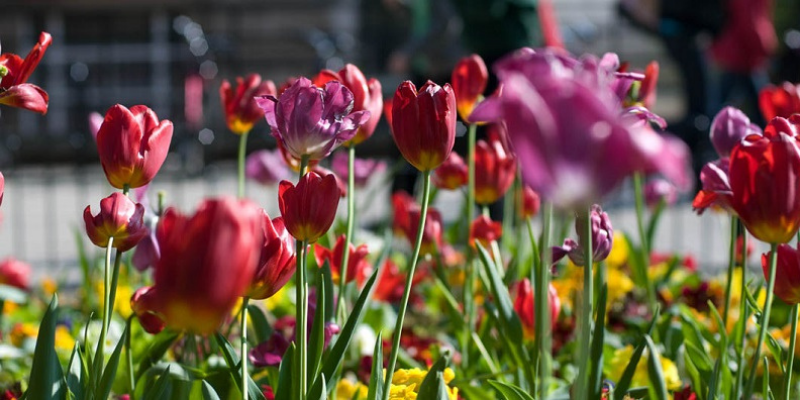Spring has arrived!

The days are getting longer, lighter and warmer; spring is truly on the way!
To celebrate the spring equinox on the 20 March, Caitlin, our Biodiversity Research Ambassador, is here to draw your attention to the new life you might be able to notice around you as spring arrives.
A welcome sight…
For me, one of the true indicators of spring is when the daffodils start to bloom, which is why they’re one of my favourite flowers. Their bright colourful petals and the promise of warmer days are a beautiful and much welcomed sight, especially after a long winter in lockdown.
What truly marks the start of spring for you? Is it the sounds of birds early in the morning? The buds growing on trees? Or maybe the return of ducklings to the Rodger Stevens Pond?
Nature really does seem to come to life in spring, so let’s explore some of the wildlife that you might be able to spot returning.
Birds in song
Many birds are returning to the UK on their summer migrations. Chiffchaffs are one of the first migrant birds to return to the UK in spring, usually in late March. Have a listen out for their characteristic two note “chiff chaff” song and see how many of this olive-brown bird you can spot up in the trees.
The dawn chorus will also start to come to life and, although you’ll have to be up early to catch it in full swing, it is a really amazing event to witness. Male birds start to sing just before sunrise to attract mates, claim territory and warn of rivals, reaching its peak around early May. So, if you’re ever up early, take the time to step outside and listen!
Bumble bees and butterflies
The sound of buzzing insect life brings with it the memories of warm summer days. The return of butterflies and their colourful wings is often a favourite indicator of spring. Butterflies can also be important indicators of the effects of climate on our wildlife by documenting the timing of emergence and population levels throughout summer.
Bumblebees will also start to make a return in March, which marks the first stage of the bumblebee lifecycles. Queen bees are busy in this time searching for nesting sites, laying her first set of eggs for the season and searching for spring pollen. If you spot a sluggish bee on the ground you can help it out by preparing a 1:1 mixture of white sugar and room temperature water and placing it next to the bee. This will help them regain their energy levels and resume their important work, every bee counts!
Flowers in bloom
Wildflowers are a colourful explosion of spring, popular with both humans and wildlife alike. Look out for bluebells, goat willow, blackthorn blossoms, orchids, wild anemones and lesser celandines.
Wild garlic is another plant that returns in full force at spring. This species can often dominate woodlands and produce a strong smell, although the taste itself is rather mild. The star-shaped flowers at the end of a single stem provide a beautiful sight across the woodland floors.
How many emerging flower species do you think you can identify? The Wildlife Watch has some great flower ID toolkits if you’re interested in developing this skill!
New-borns beginning their adventures
If you’re lucky you might also be able to spot some mammals emerging in the spring months. New-born badgers will be making their way out into the world in mid to late April and will explore further as they grow and get stronger. Spring is one of the best times of year to spot badgers as they become more active, but the overgrowth hasn’t grown so long as to conceal them.
Hedgehogs are another common spring explorer, although more difficult to spot as they are nocturnal animals. Adult hedgehogs will begin to emerge towards the end of April and new-borns are usually born in May or June. If you do happen to spot a hedgehog you can log it onto The Big Hedgehog Map which shows you all the local areas where hedgehogs have been recorded.
Did you know that the University is now a hedgehog friendly campus?
See for yourself!
I hope this will inspire you to look out and notice all the new life that is beginning to bloom around you as we celebrate the spring equinox.
If you’re interested in biodiversity and would like to get more involved with biodiversity work at the University, drop us an email at biodiversity@leeds.ac.uk.
Keep up to date on the latest news
-
- Follow us on Twitter: @UoL_Sus
- Follow us on Instagram: @uol_sus
- Follow us on Facebook: @UoLSustainability
- Sign up to our Sustainability newsletter
United Nations Sustainable Development Goals
We use the United Nations Sustainable Development Goals (SDGs) as a framework to guide our activity. Our work on biodiversity is linked to the following SDGs:
-
- Goal 3: Good Health and Wellbeing
- Goal 11: Sustainable Cities and Communities
- Goal 13: Climate Action
- Goal 15: Life on Land
Find out more about our impact on the SDGs.
